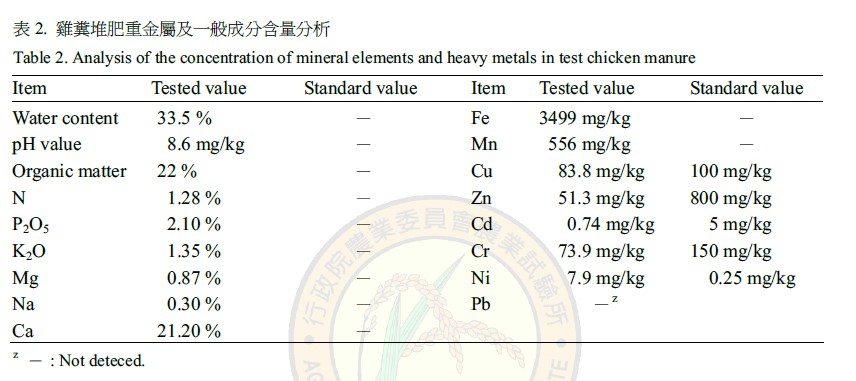All issues
Author:Min-Fu Ru, Chiling Chen, Yahn-Chir Lee, Ting-Fang Hsieh*, Chien-Liang Chu and Jih-Zu Yu
Abstract:
The purpose of this study was to establish a model of good agricultural practices suitable for cultivation of Boehmeria nivesa in the field. The effects of different types of organic and chemical fertilizers on the root yield and active ingredients of this medicinal herb crop were evaluated. The concentrations of heavy metals and mineral elements in the tested organic and chemical fertilizers, and irrigation water were measured before planting. The control measures other than synthetic pesticides were used to manage the diseases and insect pests during plant growth stage. The treatments consisted of (A) chicken manure at 7,500 kg ha-1 ; (B) chicken manure with Tricodenna sp. at 7,500 kg ha-1 ; (C) chemical fertilizer at the rate of N:P2O5:K2O = 80: 20: 120 kg ha-1 ; (D) soil amendment (AR3-2S) with chemical fertilizer (N:P2O5:K2O = 3.9: 2.23: 1.71) at 2400 kg ha-1 and (E) non-treated plot used as the control (CK). Each treatment had four replicates in a randomized complete block design (RCBD). The results showed that there were no significant differences in root yield among treatments. The fresh and dry weight of root of B. nivesa were 14,389 kg and 5,568.5 kg in treatment A, 10,056 kg and 4,082.7 kg in treatment B, 11,375 kg and 4,449.8 kg in treatment C, 16,486 kg and 6,871.4 kg in treatment D, and 8,597 kg and 3,430.2 kg in CK, respectively. The triterpenes contents in roots harvested from treatment A and B were 0.38% and 0.237%, respectively, which were significantly (p=0.05) higher than other treatments. The content of total phenolic compounds in roots harvested from CK treatment was 0.148%, which was slight higher than A and B treatments, and significantly (p=0.05) higher than C and D treatments.
Key words:Boehmeria nivesa, triterpenes, phenolic compounds, soil amendment (AR3-2S), Trichodema sp. good agricultural practices
Download:![]() PDF Links
PDF Links
- 1. Development of Tractor-Mounted Seedling Transplanter for Sweet Potato
- 2. Synergistic Effect of Additional Gas on the Toxicity of Phosphine to Sitophilus oryzae and Sitophilus zeamais (Coleoptera: Dryophthoridae)
- 3. Effects of Temperature and Solar Radiation on Growth Traits and Plant Elements in Purple Leafy Sweet Potato

 Submit your manuscript
Submit your manuscript
 Guide for authors
Guide for authors